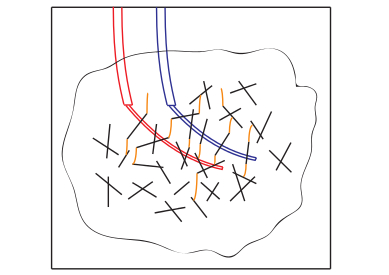
The production of electricity from deep geothermal resources is based on the circulation of fluid between two or more wells. Hot fluids are produced and feeded in geothermal power-plant. The cooled fluid is re-injected in the reservoirs – i.e. in a so-called geothermal doublet. Thanks to the abundant occurrence of temperature larger than 150°C at depth ~4 kilometers below the earth’s surface, deep geothermal resources hold the promise of providing clean base-load electricity independent of location. Unfortunately, at those depth, the rock permeability is typically too low to allow fluid circulation at economical flow rates. It is therefore necessary to engineer the permeability of the geothermal reservoir in order to obtain a sufficiently large heat flux on surface. This is achieved via hydraulic stimulation.
Mixed mode fluid driven fractures can enhance the permeability of a naturally fractured reservoir, thus allowing to sweep a larger reservoir volume during geothermal production. This technology often referred to as enhanced geothermal systems (EGS) faces several technical challenges which inhibit its industrial development. First, the lack of adequate modelling tools impede the improvement of hydraulic stimulation design resulting in costly trial and errors and sub-optimal performance. Moreover, the long term performance of the shear enhanced permeability of fractures remains poorly understood. May be more importantly, hydraulic stimulation – if not properly managed – results in uncontrolled induced seismicity.
We are currently developing a theoretical framework for the modeling of mixed-mode fluid driven propagation geared toward the stimulation of geothermal reservoirs. More generally, these tools are able to address the propagation of localized deformation features in geomaterials (faults, shear-bands, fractures) driven by multi-physics loading.